Homework for Your Clients
by Sunni Almond
Homework? If you give it, do you give it to all your clients or just a select few, and what do you give?
So, you know that place in the workout where you get to address individual needs in a much more specific way on other apparatus in the studio, because you picked up some info about the client’s body as you watched them work through the repertoire at their level of ability? Regardless of your chosen ‘Pilates Camp’, you will see things that make you cringe, and want to look the other way, or just dig in with the wrenches and screwdrivers that you have in your toolbox and get to work on either loosening, tightening, or opening the hard shell that encases the challenge. So I give homework to inspire some teamwork in moving through the challenge faster. This also helps to save the client some $$ because, as they all say, “I would love to come more often but the sessions are just so expensive.” Siri Dharma Galliano’s answer to that is the 30 min private.
Most people don’t have a spine corrector (even though I think there should be one in every home), so I have to improvise. Homework has to be quick, do-able without me standing there, and be an obvious fix or piece to the puzzle of solving the issue whether that’s
I usually give some of the wall work, or foot stuff like the pencil and marble tricks found here that are similar to the foot exercises taught by Kathi Ross-Nash or the 2×4 that I learned from Andrea Maida. I also usually give a bit of “situation-specific mat work” (a term I learned from Siri, because people don’t want to think they have an “issue”) and lately we’ve been doing some eye opening breathing games in the studio, so I throw those in too. Yes, I usually give everyone something to work on between lessons. I call them games. It takes the home ‘work’ out of it.
Posture
Check out this great TED Ed video on posture!
Posture problems are usually the ones most people can relate to in addition to tight hamstrings. So, I generally address both of these at the wall: everyone has a wall, and gravity is a huge helper here, plus the wall keeps everyone honest. There’s no jumping or jacking themselves through sticky spots, it doesn’t take long to do, the results come fairly quickly, and the whole family can do it together.
Wall roll downs are simple, self-explanatory and way easier than on the mat without a strap. This exercise targets alignment, articulation, tight low back, tight hamstrings, and abdominals:
Standing with feet as far from the wall as necessary to get the whole back against the wall, using the heels together, toes open, inner thighs magnetically pulling towards each other, arms as much to the sky as possible with biceps by the ears, shoulders properly on the back, abdominals pulled in and up, dive towards the floor, peeling off one vertebrae at a time until finger tips are as close to the floor as they can reach, a small bend in the knees may be necessary…then reverse by pressing into the feet more as the abdominals lift the spine curling its way back up the wall to the starting position, the client re-stacks their spine and plays the game again.
One day, their feet will be closer to the wall with no space between the low back and the wall, and the arms may reach even higher as the back of the neck lengthens to its proper placement, the shoulders find their proper home, and the chest opens without ribs popping.
At one of Siri Dharma Galliano’s events, I asked Alycea Ungaro about dealing with Forward Head challenges and the kyphosis that kicks in at much earlier ages now that kids have electronics and don’t go outside to play. So, of course, she used me to demo, and I struggled … I have been practicing this exercise diligently now for just over a year and have much improved my situation:
- Stand as far from the wall as required to get your whole back on it. Shoulder blades, mid and lower back, and butt should all be touching. Head may or may not touch depending on kyphosis.
- With long arms, press palms into wall firmly and hold for a count of 3, then raise arms up .. (They may or may not touch the wall depending on kyphosis). The goal is to press back of hands into the wall overhead, and hold for a count of 3 and then again low by the thighs.
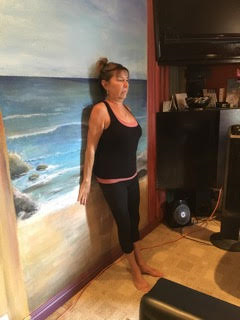
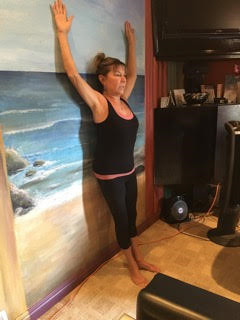
- Keep the arms going up and down until eventually they touch the wall… Maybe days, months or years… Alternate and scissor the arms.
- Finish by doing a wall roll down and roll up, finding the length. So once again, follow all the other rules without letting the low back arch off, or the ribs pop, Pilates stance, heels really pressing into each other, inner thighs totally on, etc. You know the drill.
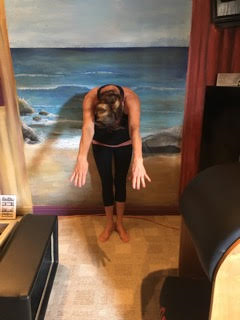
Breathing
Finally, we come to the seated or lying down breathing game. It’s the same old thing we do in the studio, I just find that most people have no idea their ribcage can move, and that they can think about how they breathe – shallow and short or long and full, on both the inhale and exhale. So simple – just using straws and pinwheels from the dollar store. Change the breath counts, inhale vs exhale, like many popular variations of the Hundred. Work on expanding the ribcage, breathing into the back, the sides, etc. (and not just the belly, which causes issues later, LOL).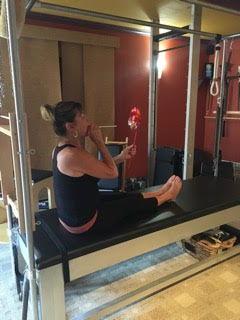
This is always eye-opening, because they are always so surprised at how short their normal breaths usually are. Big inhale through the nose, nice long exhale through the straw. Blow through the straw to spin the pinwheel, easy peasy.
I hope some of this helps the newer teacher who is still trying to figure out the actual teaching part of this job, as well as those who may be stymied as to how to get the client to pitch in help the cause.
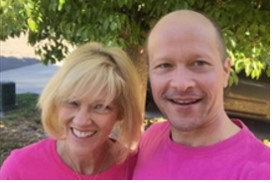 Sunni (here with Brett) is owner of Studio S Pilates in Temecula, California, which has recently hosted a few great Classical teachers, such as Alisa Wyatt, Jennifer Kries and Andrea Maida, and has some more workshops and goodies in the works for the rest of the year.
Sunni (here with Brett) is owner of Studio S Pilates in Temecula, California, which has recently hosted a few great Classical teachers, such as Alisa Wyatt, Jennifer Kries and Andrea Maida, and has some more workshops and goodies in the works for the rest of the year.
